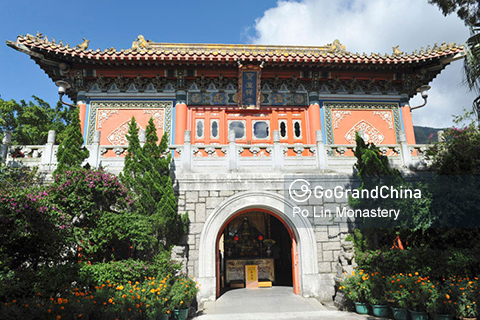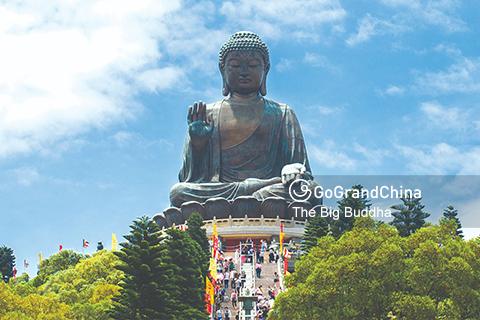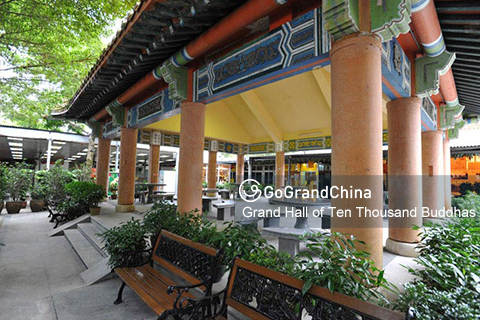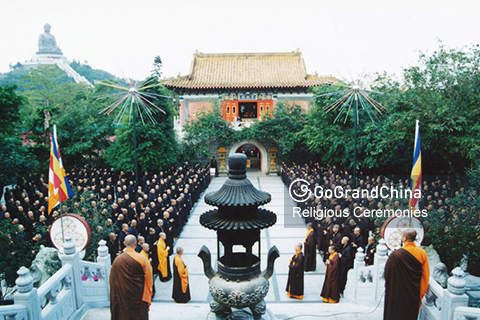You have no items in your shopping cart.
Po Lin Monastery
Introducing Po Lin Monastery (from Hong Kong Tourism Board & official website)
The Po Lin Monastery is one of Hong Kong's most important Buddhist sanctums and has been dubbed "the Buddhist World in the South". Home to many a devout monk, this monastery is rich with colourful manifestations of Buddhist iconography and its pleasant garden is alive with birdsong and flowery scents. Once merely a remote monastery hidden by lush, mountain scenery, the Po Lin Monastery made it to the world map when the extraordinary Tian Tan Buddha statue (informally known as the Big Buddha) was erected in 1993. The Big Buddha Statue has become a major landmark in Hong Kong, attracting numerous local and overseas Buddhists and visitors. It is not only a remarkable work project, but also an outstanding piece in Buddhist sculptural art in recent history. It is a valuable heritage of mankind.
Po Lin Monastery Fast Facts
• Chinese Name: Bao Lian Chan Si 宝莲禅寺
• Best Time to Visit: All year around
• Recommended Visiting Hours: 3-4 hours
• Things to Do: Photography, Hiking, Buddhism
• Opening Hours: 10:00-17:30 for Tian Tan Big Buddha; 08:00-18:00 for the Po Lin Monastery
• Entrance Fee: Free
• Address: Po Lin Monastery, Ngong Ping, Lantau Island, Hong Kong
What to expect at Po Lin Monastery
History of the Monastery
Po Lin Monastery was known as the 'Big Thatched Hut' in the early days more than a century ago. In 1906, three Buddhist monks of the Ch'an School, Venerables Da Yue, Dun Xiu and Yue Ming traveled from Jiangsu Province of China to Lantau Island to set up a site for practice. Since then, many members of the Sangha from all directions were attracted to the place, marking the gradual rise of the Ch'an (Zen) School of Buddhism in Hong Kong. In 1924, the 'Big Thatched Hut' was renamed Po Lin Monastery and Venerable Ji Xiu became the first Abbot. Since then, Po Lin Monastery has developed into a world renowned monastery.
The Big Buddha (Tian Tan Buddha)
The Big Buddha on Lantau Island is the biggest sitting Buddha statue built outdoor. This majestic statue sits atop the peak of Mount Muk Yue. Po Lin Monastery has taken 12 years to plan and build this bronze Buddha statue that symbolizes the stability of Hong Kong, prosperity of China and peace on earth. Sitting 34 metres high and facing north to look over the Chinese people, this majestic bronze Buddha draws pilgrims from all over Asia. The eyes, lips, incline of the head and right hand, which is raised to deliver a blessing to all, combine to bring a humbling depth of character and dignity to the massive Buddha. Climb the 268 steps for to reach the base of the statue. From the top of the stairs, not only do you get breath-taking views over Lantau’s verdant mountain terrain and across the South China Sea, you also get a bird’s eye view of the century-old Po Lin Monastery and its many colourful murals, which you can visit after descending the steps.


Architectural Features
Po Lin Monastery's complex of buildings and structures, since its early days as an austere thatched hut, sits at the middle of Lantau Island, between Lantau Peak and Lei Nak Peak, on Ngon Ping, a level plateau. Facing the Big Buddha, the monastery's major structures sit tightly on the north-eastern to south-western axis, looking over the South China Sea.
Along the axis, San Men (Mountain Gate) would lead up to the Hall of Skanda Bodhisattva, the Main Shrine Hall of Buddha, and the Grand Hall of Ten Thousand Buddhas. On the flanks, in symmetrical arrangements, are the Bell Tower and the Drum Tower, the Hall of Ksitigarbha Bodhisattva, the Meditation Hall, the Dining Hall and the Sangha Hall. These edifices combine to form an orderly monastery complex, enclosing and creating roomy space and airy courtyards. On the south side of the axis are the Po Lin Hall and the facility for ceremonial and religious activities.
The Main Shrine Hall of Buddha was completed in 1970. It is a seven-span structure with a double-eaves gablet roof, adopting Ming and Qing's palatial architectural design. The Eighties of the last century witnessed a close and intimate relationship between Hong Kong's Buddhist order with the Mainland, and this has in no small measure facilitated the building of the Tian Tan (Altar of Heaven) Big Buddha, the construction work of which had commenced in 1981 and was completed in 1993, and Di Tan (Altar of Earth). Both have followed the design of Tian Tan's Hall of Prayer for Good Harvests, including that of the base platform. They have also incorporated the engineering and technological expertise of China's National Space Administration. The completion of the Big Buddha has indeed laid a major architectural milestone for the monastery. It also exemplifies the monastery's leading role and influence in religious orders and tourism.
The Grand Hall of Ten Thousand Buddhas went on the drawing board in 2000 and was completed in 2014. It adopts the classical architectural concepts of Song dynasty and includes a shrine hall, an exhibition hall, a meditation hall, an abbot's chamber, a scripture library and other multi-functional facility.
In its effort in spreading Buddhism and in moving forward towards globalization, the monastery has changed its architectural concept from local southern China to that of Beijing palatial design. Looking back on its development in the past one hundred years, Po Lin Monastery is now looking ahead for a new stage of progress, with a renewed image of national identity.


How to get to Po Lin Monastery
• Take Ngong Ping Cable Car at the Cable Car Station outside Tung Chung MTR Station (travelling time: about 25 minutes); take an additional 10-minute walk to the Monastery.
• Take Lantau Bus No. 23 at the bus station outside Tung Chung MTR Station to Ngong Ping Bus Terminus (travelling time: about 45 minutes).
• Take First Ferry from Central Pier to Mui Wo, and take Lantau Bus No.2 to Ngong Ping Bus Terminus (travelling time from Mui Wo to Ngong Ping: about 35 minutes).
• Take Lantau Bus No. 21 at the bus stop in Tai O to Ngong Ping Bus Terminus (travelling time: about 15 minutes).
• Rent a car/bus from GGC to enjoy a hassle free private transfer from hotels in Hong Kong to Po Lin Monastery.
Additional travel advice on Po Lin Monastery
• Please wear comfortable hiking shoes.
• Visitors can enlighten your appetite at the popular vegetarian restaurant in the monastery.
• The Big Buddha is currently undergoing renovations. The Big Buddha statue is covered and the halls under the statue and upper part of the steps are closed. All religious ceremonies and events will continue as usual, please check the official website before you visit.
There are no products matching the selection.


